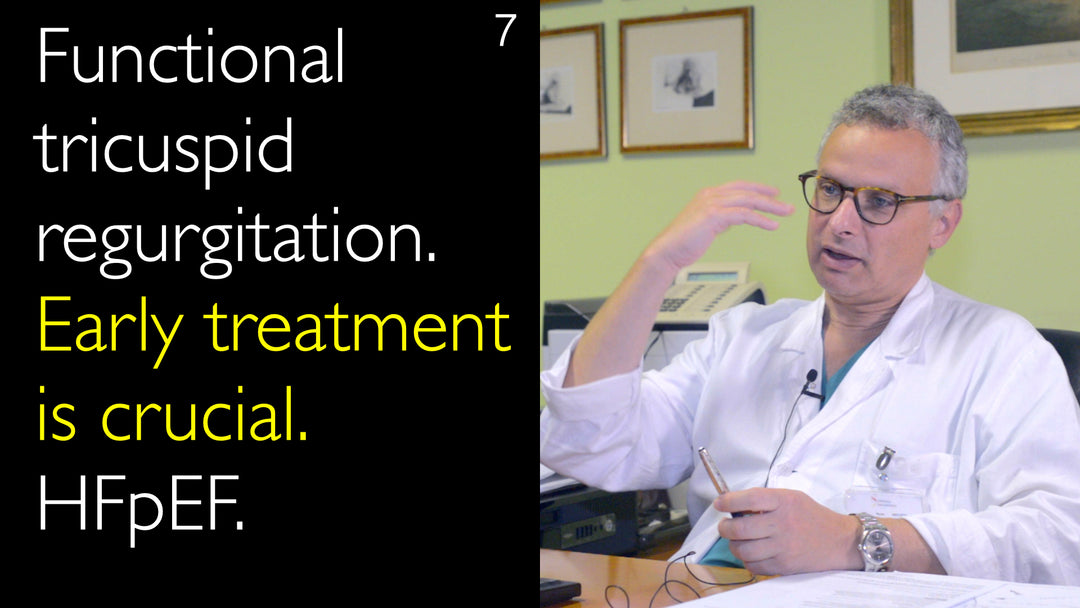Leading expert in tricuspid valve disease, Dr. Francesco Maisano, MD, explains the critical importance of early intervention for functional tricuspid regurgitation. He details the three main causes of secondary TR and why its symptoms are often underestimated. Dr. Maisano clarifies that surgical risk is only high in patients with advanced organ failure, advocating for treatment before overt right heart failure develops. He also discusses the significant link between TR and heart failure with preserved ejection fraction (HFpEF).
Early Diagnosis and Treatment of Functional Tricuspid Regurgitation
Jump To Section
- Causes of Functional Tricuspid Regurgitation
- Underestimated Symptoms of Tricuspid Regurgitation
- Surgical Risk Misconceptions
- New Treatments Increase Intervention Rates
- Link Between HFpEF and Tricuspid Regurgitation
- Full Transcript
Causes of Functional Tricuspid Regurgitation
Functional tricuspid regurgitation is a secondary condition caused by other underlying cardiac issues. Dr. Francesco Maisano, MD, identifies three primary causes. The first is pulmonary artery hypertension, which can result from left-sided heart diseases like mitral regurgitation or aortic stenosis. The second cause is ventricular dysfunction, where a dilated ventricle, often from long-standing left heart disease, leads to valve leakage. The third and increasingly recognized cause is iatrogenic tricuspid regurgitation, frequently seen in patients with atrial fibrillation and dilated right atria.
Underestimated Symptoms of Tricuspid Regurgitation
The symptoms of functional tricuspid regurgitation are often subtle and easily missed. Dr. Francesco Maisano, MD, emphasizes that many patients do not present with classic signs of right heart failure like swollen legs or ascites. Instead, they may experience profound fatigue and dyspnea while remaining euvolemic. He illustrates this with a case of a patient whose main symptom was fatigue, caused by a critically low resting cardiac index of 1.4. This low cardiac output leads to organ failure over time, making treatment much more difficult if the condition is not addressed early.
Surgical Risk Misconceptions
A major barrier to treating tricuspid regurgitation is the misconception that surgery is universally high-risk. Dr. Maisano clarifies that this is only true for patients who have developed advanced organ failure. Registry data shows an overall mortality rate of around 8% for isolated tricuspid valve surgery, which can soar to 50% in late-stage cases. However, for patients treated early, before the onset of severe hepatic or renal dysfunction, the surgical risk can be as low as 0%. Dr. Francesco Maisano, MD, argues that waiting for overt right heart failure signs means operating when it is too late, resulting in prohibitively high mortality rates above 20%.
New Treatments Increase Intervention Rates
The advent of less invasive, endovascular procedures is transforming the treatment landscape for tricuspid regurgitation. Dr. Francesco Maisano, MD, notes that these safer interventions are leading to earlier patient referrals. This is increasing the overall number of candidates for tricuspid valve treatment, both surgical and transcatheter. He predicts a significant global rise in intervention rates as the medical community recognizes that severe TR carries a prognostic impact as serious as mitral regurgitation. This shift is crucial because it allows treatment before patients cross the threshold into irreversible organ failure.
Link Between HFpEF and Tricuspid Regurgitation
There is a strong connection between heart failure with preserved ejection fraction (HFpEF) and the development of isolated tricuspid regurgitation. Dr. Francesco Maisano, MD, explains that HFpEF patients often have diastolic issues, hypertension, and atrial fibrillation—all classic conditions associated with TR. This patient population, frequently female, is a key group where tricuspid interventions could play a vital role. He also highlights low-flow, low-gradient aortic stenosis as another condition where severe TR may be a hidden culprit behind reduced cardiac output. In any low-flow state, evaluating the tricuspid valve is essential, as right-sided heart failure does not cause pulmonary edema, allowing symptoms to remain deceptively mild until advanced stages.
Full Transcript
Dr. Anton Titov, MD: Tricuspid valve disease affects 1.6 million patients in the United States, but only 8,000 of them undergo tricuspid valve surgery annually. You wrote about that in one of your reviews. Historically, there have been very few therapy options for tricuspid regurgitation, but the prognosis in functional tricuspid regurgitation historically has been quite poor. What are the main causes of functional tricuspid valve regurgitation?
Dr. Francesco Maisano, MD: Functional tricuspid valve regurgitation is, first of all, a disease that is diagnosed more and more often. There is more attention and multiple reasons for a better diagnosis of tricuspid regurgitation. In principle, when we talk about "functional" tricuspid regurgitation, it means "secondary" to something else.
Usually, there are three diseases which are the most important causes. Pulmonary artery hypertension, so tricuspid regurgitation is secondary to something happening on the left side of the heart. Tricuspid regurgitation could be secondary to mitral regurgitation or to aortic stenosis, or to primary pulmonary hypertension.
Then we have problems with the ventricular function. Those patients may have dilated ventricles; patients may have even low pulmonary artery pressure, but they have very dilated ventricles. This can be the result of many years of left-sided heart disease. Or sometimes it could be due to many years of primary tricuspid regurgitation, which becomes functional tricuspid regurgitation to some extent.
And then you have the iatrogenic tricuspid regurgitation. This is a subcategory that is coming more and more under the spotlight. We have specialists looking at the right side of the heart. We see patients with mainly atrial fibrillation with dilated right atria, which will develop isolated tricuspid regurgitation.
Now, these patients have been identified to have a higher risk. They have a worse prognosis. It is not as good as in those patients without tricuspid regurgitation. So we know today that tricuspid regurgitation (TR) is not benign anymore.
What is also interesting is this. Patients with functional mitral regurgitation may be asymptomatic for the typical symptoms. You expect these patients to have swollen legs or to have ascites, but many of these patients have nothing of that. They still have a status of compensation. These patients are euvolemic. They have no congestion signs.
Still, they are dyspneic. They have fatigue. They don't do well. Tomorrow I will operate a lady for that. For instance, she has very thin legs. She never had swollen legs in her life. She takes a bit of the diuretics, but she's good. But her right ventricle is becoming bigger and bigger. It is dilated now.
And now, this is a certain indication for tricuspid valve surgery by guidelines. She has only fatigue as a symptom. We did a right-sided cardiac catheterization in this lady. We know why she has fatigue because she has a cardiac index at the rest of 1.4.
So what happens in these patients is this. The cardiac output is decreased; they still can increase cardiac output under exercise. But they always feel fatigued because their heart is slowing down. So there are a lot of these patients with very subtle signs of dysfunction, which are probably underestimated.
Patients with tricuspid regurgitation have symptoms that are underestimated. But these patients, over time, develop organ failure, and then they become almost impossible to treat. So tricuspid valve is no more a forgotten valve, but it is a poorly understood heart valve. We are still learning, and we learn more every day.
What we see is very interesting. First of all, you said that very few patients with tricuspid regurgitation are operated on. Then you should ask, why? There are two reasons, basically. One reason is that there is a common feeling that surgery for isolated tricuspid regurgitation is a high-risk procedure with 8% overall mortality. This is what you see in almost every CTS Register today.
Mortality can be predicted as high as 50% in some patients. But mortality also can be as low as zero in those patients where the tricuspid regurgitation treatment procedure is done early. This is like in a patient I will operate on tomorrow. She has a risk predicted by free score, which is one of the latest scores, zero. She has zero risk of tricuspid regurgitation treatment procedure. Hopefully, I will stay within this risk profile.
Now the other reason, besides the misconception that tricuspid surgery is high-risk, it is true, but only for those with organ failure. The other problem is that people think that tricuspid regurgitation is a benign pathology. And if there are no symptoms of right ventricular failure, then you should not treat these patients.
Then everybody is waiting for renal dysfunction, for patients to have hepatic dysfunction, severe dyspnea, swollen legs, overt signs of right heart failure. These patients are already too late to be treated. We should not wait for this kind of symptom.
That's the reason why we have very few patients with functional tricuspid regurgitation treated. Because you wait until patients cross that threshold of organ failure. And then you operate when the patient is already too late. And then the risk of surgery goes beyond 20%. And that's why in the end, we had not seen many patients for tricuspid regurgitation treatment surgery.
Now, it's very interesting, though, is that we have a pretty busy practice for tricuspid regurgitation interventions. So these are endovascular procedures. And so people start watching these patients and start thinking about less invasive and more safe procedures. So we get referred patients with tricuspid valve disease earlier now.
And this is increasing the number of potential surgical candidates. We see many more now. You will see, I can predict an increased rate of tricuspid valve disease intervention overall in the world because of the advent of new procedures because there is now an understanding that tricuspid valve regurgitation has a prognostic impact as strong as the mitral valve regurgitation.
Dr. Anton Titov, MD: Is there an increase in tricuspid valve regurgitation that you see for potentially surgically treatable patients in heart failure with preserved ejection fraction (HFpEF)?
Dr. Francesco Maisano, MD: Heart failure with preserved ejection fraction is for sure one of those diseases where you can see isolated tricuspid regurgitation. These patients have a diastolic issue. This is usually they have hypertension; very often they have atrial fibrillation. So these are the typical patients. They are female.
So, all these typical conditions are the same, which we find in isolated tricuspid regurgitation. So yes, there is a potential role of these procedures specified in this field (heart failure with preserved ejection fraction). Very close to this heart failure with preserved ejection fraction, you have the low-flow, low-gradient aortic stenosis.
I think there may be many patients with severe tricuspid regurgitation in these diseases. So every situation where you have a low-flow status, you should check the tricuspid heart valve because the tricuspid heart valve can be the reason for the reduction of cardiac output.
Because the right side of the heart can tolerate low cardiac outputs, and patients can be without symptoms. It is different from the left side of the heart, where if you have any moment where you have very low cardiac output, you will develop pulmonary edema. This doesn't happen for right-sided heart failure in patients with tricuspid regurgitation.




